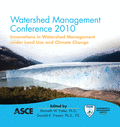Removing Barriers to Fish Passage at the City of Bellingham's Middle Fork Nooksack River Diversion Dam
Publication: Watershed Management 2010: Innovations in Watershed Management under Land Use and Climate Change
Abstract
The City of Bellingham, Washington (2008 population, 76,130) constructed a diversion dam and tunnel project on the Middle Fork of the Nooksack River in the early 1960's to divert supplemental water into Lake Whatcom, the City's primary municipal source of water supply. The City is located on Puget Sound, about 90 miles north of Seattle, and 21 miles south of the U.S. — Canada border. See below Figure 1, Project Vicinity map. The diversion dam is located in a steep and narrow gorge on the Middle Fork Nooksack River on the heavily forested western slopes of Mt Baker in northwestern Washington, about 20 miles south of the U.S. — Canada border. The diversion dam site is characterized by steep forested slopes, a boulder and cobble streambed with numerous bedrock outcrops, and a steep pool and cascade channel morphology. The Middle Fork Nooksack River Diversion Dam is shown in Figure 2. When the diversion dam was constructed in 1960-61, there was little awareness in the community of either fish passage issues or the looming decline in Pacific Northwest salmonid stocks. Therefore, no fish passage provisions were included in the design of the 30 foot tall by 150 foot long concrete dam. Completion of the dam and diversion tunnel in 1961 therefore cut off approximately 9 miles of potential salmon habitat river channel. Although there are no definitive written records of salmon being present in the upper Middle Fork Nooksack watershed prior to completion of the dam, anecdotal information from Native American oral sources indicate that anadromous fish were present in the upper watershed before European settlement began in the area in the 1850's, and fisheries biologists generally believe that salmon could survive in the upper reaches of the Middle Fork of the Nooksack River if they could somehow get past the passage barrier created by the diversion dam. By the beginning of the 21st Century, the dam and diversion gate structure were starting to show the effects of the ravages of time from the cumulative effects of more than 40 severe Washington Cascades winters, and the abrasive effects on the concrete dam spillway of the pulverized "rock flour" entrained in the river water derived from Mt Baker's alpine glaciers in the headwaters of the watershed. The need to repair and rehabilitate the facility was becoming readily apparent. By that time also, the prevailing public sentiment in this former timber, shipping, and fishing town, now reborn as a highly desirable cosmopolitan university town that was rapidly attracting new residents from throughout the Puget Sound region and beyond, had been transformed by the environmental movement. A strong community desire to remove this barrier to Salmon migration by either adding a fish ladder to the existing dam, or constructing a new diversion facility that would not require a diversion dam for its operation, had firmly taken root. The City Council made elimination of this barrier to fish passage a priority for the City, and City staff formed a partnership with two local Native American tribes, the Nooksack Indian Tribe, the Lummi Nation, and the Washington Department of Fish and Wildlife to search for a workable solution.
Get full access to this article
View all available purchase options and get full access to this chapter.
Information & Authors
Information
Published In
Copyright
© 2010 American Society of Civil Engineers.
History
Published online: Apr 26, 2012
Authors
Metrics & Citations
Metrics
Citations
Download citation
If you have the appropriate software installed, you can download article citation data to the citation manager of your choice. Simply select your manager software from the list below and click Download.
